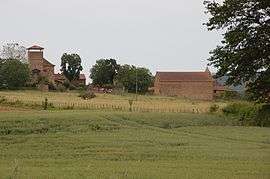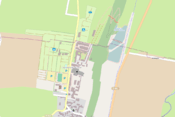Taizé, Saône-et-Loire
| Taizé | |
|---|---|
 | |
 Taizé | |
|
Location within Bourgogne-Franche-Comté region  Taizé | |
| Coordinates: 46°30′51″N 4°40′39″E / 46.5142°N 4.6775°ECoordinates: 46°30′51″N 4°40′39″E / 46.5142°N 4.6775°E | |
| Country | France |
| Region | Bourgogne-Franche-Comté |
| Department | Saône-et-Loire |
| Arrondissement | Mâcon |
| Canton | Saint-Gengoux-le-National |
| Intercommunality | entre Grosne et Guye |
| Government | |
| • Mayor (2008–2014) | Georges Bouillin |
| Area1 | 3.16 km2 (1.22 sq mi) |
| Population (2006)2 | 184 |
| • Density | 58/km2 (150/sq mi) |
| Time zone | CET (UTC+1) |
| • Summer (DST) | CEST (UTC+2) |
| INSEE/Postal code | 71532 / 71250 |
| Elevation |
210–263 m (689–863 ft) (avg. 215 m or 705 ft) |
|
1 French Land Register data, which excludes lakes, ponds, glaciers > 1 km² (0.386 sq mi or 247 acres) and river estuaries. 2 Population without double counting: residents of multiple communes (e.g., students and military personnel) only counted once. | |
Taizé is a commune in the Saône-et-Loire department in the region of Bourgogne-Franche-Comté in eastern France. The commune lies 33 kilometres (21 mi) northwest of Mâcon, the capital of Saône-et-Loire. Macon itself is south of the town of Cluny.
Pilgrimage site
The commune contains two churches; the small Parish church and the much larger "Church of Reconciliation". The latter church can hold over 6,000 people. Both churches are run by the Taizé Community, an ecumenical monastic community founded in 1940 by Brother Roger. It is composed of more than one hundred brothers, from Protestant and Catholic traditions, who originate from about thirty countries across the world.[1]
Taizé is today known as a place of pilgrimage, primarily for young adults: every week, hundreds and thousands of visitors, generally between the ages of 17 and 30, visit Taizé for an experience of prayer and communal life.
Geography
The commune has an area of 3.16 kilometers. The river Grosne forms all of the commune's western border.
Miscellaneous
The asteroid 100033 Taizé was discovered by Freimut Börngen on April 9, 1990. It is named in honour of Taizé.[2]
Gallery
|
See also
References
- ↑ The Oxford companion to Christian thought. Oxford: Oxford University Press. 2000. ISBN 9780198600244. Retrieved 12 August 2014.
- ↑ "JPL Small-Body Database Browser". NASA. Retrieved 12 August 2014.
External links
| Wikimedia Commons has media related to Taizé. |
